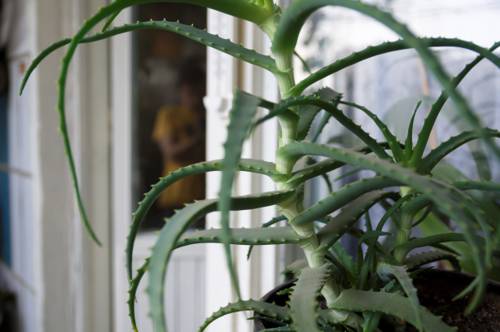
FAQ About Indoor Plant Metabolic Processes

What are the main metabolic processes in indoor plants?
Indoor plants primarily undergo three main metabolic processes: photosynthesis, respiration, and nutrient uptake. During photosynthesis, plants convert light energy, usually from sunlight, into chemical energy in the form of glucose, while releasing oxygen as a by-product. Respiration is the process where plants use glucose and oxygen to produce energy, carbon dioxide, and water. Nutrient uptake involves the absorption of essential minerals and water from the soil, which are necessary for the plant's growth and overall health.

How does photosynthesis occur in indoor plants?
Photosynthesis in indoor plants occurs in the chloroplasts of plant cells. This process uses light energy, typically from sunlight or artificial grow lights, to convert carbon dioxide and water into glucose and oxygen. The process includes two main stages: the light-dependent reactions and the Calvin cycle (light-independent reactions). The light-dependent reactions capture the energy from light, which is then used in the Calvin cycle to synthesize glucose.

Why is light important for the photosynthesis of indoor plants?
Light is crucial for photosynthesis because it provides the energy needed to drive the light-dependent reactions. Without sufficient light, the plants cannot produce enough glucose to sustain themselves. This energy is used to convert carbon dioxide and water into glucose and oxygen, facilitating growth and maintenance of the plant. Artificial lights can be used as a substitute when natural sunlight is limited.

What role does respiration play in the metabolism of indoor plants?
Respiration is a vital metabolic process for indoor plants as it provides the energy required for various physiological activities. In this process, glucose produced during photosynthesis is broken down with the help of oxygen, releasing energy in the form of ATP (adenosine triphosphate), along with carbon dioxide and water. This energy is essential for growth, reproduction, and repair of plant tissues.

How do indoor plants manage nutrient uptake?
Indoor plants manage nutrient uptake through their root systems. Roots absorb water and essential minerals from the soil, which are transported to different parts of the plant. The uptake process is influenced by factors such as soil pH, moisture, and the presence of adequate nutrients in the soil. Fertilizers can be used to supplement soil nutrients, ensuring that plants receive the necessary elements like nitrogen, phosphorus, and potassium for optimal growth.

What are common nutrients required by indoor plants?
Indoor plants require a variety of essential nutrients to thrive. The primary macronutrients include nitrogen (N), phosphorus (P), and potassium (K), which are crucial for plant growth and development. Secondary macronutrients such as calcium (Ca), magnesium (Mg), and sulfur (S) are also needed in smaller quantities. Additionally, micronutrients like iron (Fe), manganese (Mn), zinc (Zn), copper (Cu), boron (B), and molybdenum (Mo) are vital for specific plant functions.

Can indoor lighting affect the photosynthesis of plants?
Yes, indoor lighting can significantly affect the photosynthesis of plants. The intensity, duration, and spectrum of light influence the rate of photosynthesis. While natural sunlight is ideal, modern grow lights can be used to mimic sunlight conditions indoors. LED grow lights, for example, can provide the specific wavelengths of light required for optimal photosynthesis, thus improving plant growth and health.

How do indoor plants adapt their respiration process?
Indoor plants can adapt their respiration processes based on their environment. For instance, plants might adjust their stomatal opening to manage gas exchange effectively, reducing water loss while optimizing oxygen and carbon dioxide exchange. Changes in temperature and light conditions can also influence respiration rates, with warmer temperatures generally increasing the rate of respiration.

What happens if indoor plants don't get enough nutrients?
If indoor plants do not receive adequate nutrients, they may experience stunted growth, yellowing of leaves, poor flowering, and reduced resistance to diseases. Nutrient deficiencies can affect various physiological processes and can lead to visible symptoms like chlorosis (lack of chlorophyll) or necrosis (cell death). It's essential to routinely check and amend the soil with the necessary fertilizers to prevent such deficiencies.

How does water affect the metabolic processes of indoor plants?
Water is crucial for the metabolic processes of indoor plants as it plays a key role in photosynthesis and nutrient uptake. It acts as a medium for transporting nutrients from the soil to different parts of the plant. Moreover, water maintains cell turgor, which is essential for structural support and growth. Insufficient water can lead to wilting and reduced photosynthetic efficiency, whereas overwatering can cause root rot.

What is the role of CO2 in the metabolism of indoor plants?
Carbon dioxide (CO2) is a vital component of the photosynthesis process in indoor plants. Plants absorb CO2 from the air through stomata in their leaves, using it alongside water to produce glucose and oxygen. This glucose serves as an energy source for growth and physiological functions. Adequate levels of CO2 are necessary to ensure efficient photosynthesis and overall plant health.

How can you improve the photosynthesis rate of indoor plants?
To improve the photosynthesis rate of indoor plants, ensure they receive adequate light, preferably with a full spectrum similar to sunlight. Position plants near windows for natural light or use artificial grow lights. Maintain optimal temperatures as extremes can hinder photosynthesis. Lastly, manage CO2 levels and ensure that the plants' watering and nutrient needs are adequately met.

What are the signs of respiratory stress in indoor plants?
Signs of respiratory stress in indoor plants may include wilting, leaf drop, slow growth, and failure to flower or produce fruits. This can occur due to inadequate oxygen levels, poor soil aeration, overwatering, or extreme temperature fluctuations. Ensuring adequate ventilation and proper soil structure can help alleviate respiratory stress.

Does photosynthesis in indoor plants only occur during the day?
Yes, photosynthesis in indoor plants primarily occurs during daylight when light energy is available. The light-dependent reactions that capture solar energy happen only in the presence of light. At night, plants continue to respire, consuming oxygen and glucose to generate energy while releasing carbon dioxide.

What environmental factors can inhibit indoor plant metabolism?
Various environmental factors can inhibit the metabolism of indoor plants, including insufficient light, inappropriate temperatures, low humidity, poor soil composition, and inadequate watering. Also, limited access to all necessary nutrients and high levels of air pollution can negatively affect metabolic processes. Providing the right conditions is crucial for maintaining healthy metabolic activity.

How do indoor plants balance photosynthesis and respiration?
Indoor plants balance their photosynthesis and respiration activities by aligning them with the light and dark cycles. During the day, photosynthesis predominates, utilizing light to produce glucose and oxygen. At night, or in darkness, respiration continues as plants consume the stored glucose to release energy necessary for growth and repair. This balance ensures plants maintain energy for their metabolic needs.

What is the significance of stomata in plant metabolism?
Stomata are tiny openings on the surface of leaves that play a critical role in plant metabolism by regulating gas exchange. They allow carbon dioxide to enter for photosynthesis and oxygen to exit as a by-product. Stomatal openings also facilitate the release of water vapor during transpiration, affecting water uptake and nutrient transportation in plants. Proper functioning of stomata is essential for optimal plant metabolic processes.

Can indoor plants continue to grow without direct sunlight?
Indoor plants can continue to grow without direct sunlight, provided they receive adequate light from artificial sources. Many grow lights are designed to supply the necessary spectrum and intensity required for photosynthesis, enabling plants to continue their growth and metabolic processes indoors. However, not all plants are suited for low-light conditions, so selecting appropriate species is crucial.

What role do chloroplasts play in indoor plant metabolism?
Chloroplasts are essential organelles in plant cells that facilitate photosynthesis by capturing light energy and converting it into chemical energy in the form of glucose. They house the green pigment chlorophyll, which absorbs light and drives the light-dependent reactions of photosynthesis. Chloroplasts are crucial for energy production, enabling plants to perform various metabolic processes effectively.

How does temperature influence the metabolic processes of indoor plants?
Temperature significantly influences the metabolic processes of indoor plants. Optimal temperatures help maximize photosynthesis and respiration rates, promoting healthy growth. Too low temperatures can slow down metabolic activities, while excessively high temperatures may denature enzymes essential for these processes, reducing efficiency. Maintaining the right temperature range helps ensure proper metabolic functioning.
